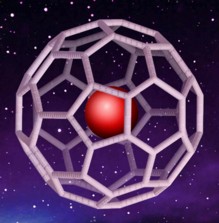
|
||||||
|
|
||||||
|
|
|
Apocolypse then
"If the species cannot adjust, they perish. It's a survival-of-the-fittest sort of thing," said Becker. "To knock out 90 percent of organisms, youðve got to attack them on more than one front." Scientists don't know the site of the impact 250 million years ago, when all Earth's land formed a supercontinent called Pangea. However, the space body left a calling card -- complex carbon molecules called buckminsterfullerenes, or Buckyballs, with the noble gases helium and argon trapped inside the caged structure. Fullerenes, which contain at least 60 carbon atoms and have a structure resembling a soccer ball or a geodesic dome, are named for Buckminster Fuller, inventor of the geodesic dome. The researchers know these particular Buckyballs are extraterrestrial because the noble gases trapped inside have an unusual ratio of isotopes, atoms whose nuclei have the same number of protons but different numbers of neutrons. Terrestrial helium is mostly helium-4 (two neutrons and two protons), while extraterrestrial helium is enriched with helium-3 (one neutron and two protons). "These things form in carbon stars. That's what's exciting about finding fullerenes as a tracer," Becker said. The extreme temperatures and gas pressures in carbon stars are perhaps the only way extraterrestrial noble gases could be forced inside a fullerene, she explained. These gas-laden fullerenes were formed outside the Solar System, and their concentration in the sedimentary layer at the boundary of the Permian and Triassic periods means they were delivered by comets or asteroids. The researchers estimate the comet or asteroid was roughly 6 to 12 kilometers across, or about the same size as the asteroid believed responsible for wiping out the dinosaurs 65 million years ago. The telltale fullerenes containing helium and argon were extracted from sites where the Permian-Triassic boundary layer had been exposed in Japan, China and Hungary. The evidence was not as strong from the Hungary site, but the China and Japan samples bear strong evidence, Becker said.
The team's work was made more difficult because there are few
250 million-year-old rocks left on Earth. Most rocks that old
have been recycled through the planet's tectonic processes.
"It took us two years to do this research, to try to
narrow it down enough so that we could see this fullerene
signature," Becker said. Previously, scientists thought that any asteroid or comet collision would leave strong evidence of the element iridium, the signal found in the sedimentary layer from the time of the dinosaur extinction. Iridium was found at the Permian-Triassic boundary, but not nearly in the concentration as from the dinosaur extinction. Becker believes that difference is because the two space bodies that slammed into Earth had different compositions. This press release provided by NASA, February 23, 2001
|
||||
|
|
||||||
